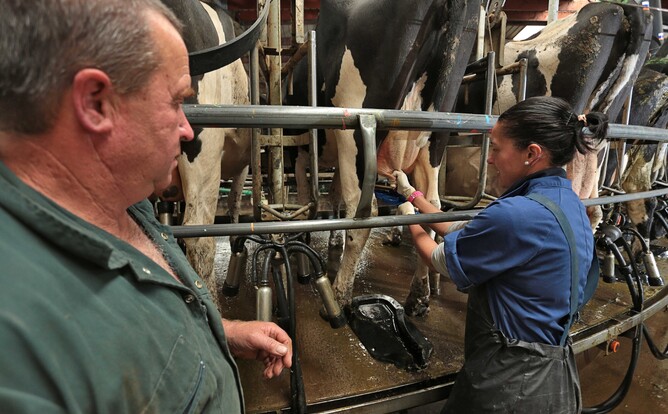What is mastitis?
A common disease after calving, mastitis is an inflammation of the mammary gland caused by bacteria getting into the udder.
While sub-clinical cases don’t have any outward changes, only a high somatic cell count, clinical cases can be visually identified. An affected cow’s udder will be hot, hard, swollen, and sore. Her milk will look different – it could be thinner or thicker than usual, or an unusual colour. She may appear uncomfortable and, as it becomes severe, be unwilling to move around and could even go down.
Bacteria enters through the hole at the end of a teat end. It can be made easier for the bacteria to enter the udder when there is hyperkeratosis – thickening of the skin around the teat canal. Like a callus, skin on the tip of the teat gets rough as a response to trauma or over-use, such as improper cup placement or pulsation, or excessive or prolonged vacuum. Teats can heal from this damage over time, but while they are affected the teat canal’s ability to resist infection is compromised and mastitis is highly likely.
Once inside, somatic cells try to fight the bacteria, increasing their numbers as the infection grows. Infection can occur in multiple quarters of the udder or just one quarter, as each quarter has entirely separate workings.
Even if the cow heals, her production in that quarter will be affected going forward and her cell count will remain slightly elevated. She may need to become a three-titter and will be at a higher risk of being culled from the herd.
Early detection gives better chances of being cured and reducing long-term damage to the udder, but minimising the number of cows getting infections is best.
What are some practical steps to reduce cases?
More infections occur when there is more bacteria near the teat end. Unfortunately, spring weather in the south produces two of the worst offenders: mud and moisture!
Try to avoid muddy paddocks and long walks on messy lanes, where possible. Shed cleanliness is important, however, it’s not recommended to hose near cows as muck can flick up onto their udders. Happy cows shouldn’t be pooing much in the shed, so it might be worth looking into what you can change to make milking time less stressful.
Wiping the worst of the muck off the teats with a dry cloth before putting the cups on can help prevent dirt from entering the teat during the milking process. If you wash udders down with water, ensure you properly dry them before cupping. Wearing gloves is also essential to stop the spread of bacteria.
Look at her udder while cupping. Does one quarter look different? If you strip (manually milk) her teat, what does the milk look like? Spotting cases and not cupping the affected quarter is vital so infection isn’t passed between cows on the liners. Plus, nobody wants bad milk to go in the vat and risk a fine or milk refusal. Have a system for marking affected cows and which quarter (or quarters) the mastitis is in. Even though the quarter shouldn’t be cupped, fully stripping it out each milking can help flush out the infection.
Teat spray thoroughly; covering everywhere the liner has touched will kill bacteria and lower the risk of cross-contamination. It also keeps the teat skin soft, reducing the chances of it getting cracked. Teat grease can be used for this purpose too.
Need help with mastitis management on your farm?
RMT solution is useful for checking for mastitis during milking and simple paddles make testing easy. The infection reacts with the solution when the cell count is high and causes the milk mix to change consistency. Sub-clinical cases that can’t be detected by eye can sometimes also be picked up by this testing. So, if the overall cell count is high in your milk, then you could use this method to test the whole herd and discover your affected cows. Our vet techs can give you a hand with this.
We can also test milk samples in the clinic to help diagnose mastitis cases and offer treatment recommendations. Grab a few of our sterile test pottles when you’re next in town. Keep samples clean and refrigerated.
If you experience a lot of mastitis infections this spring, have a chat to your KeyVet and we can come out for a visit to help you identify problem areas.

